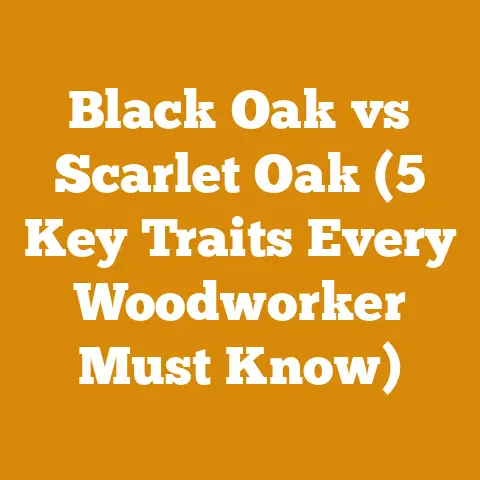Cooking on a Wood Burning Stove Top (Surprising Tips for Tree Workers)
In today’s fast-paced world, finding moments of peace and connection is more important than ever. Whether you’re a seasoned tree worker, a passionate homesteader, or simply someone who appreciates the warmth and charm of a wood-burning stove, the idea of cooking on one can be incredibly appealing. It’s not just about preparing a meal; it’s about embracing a slower, more deliberate way of life, connecting with the elements, and maybe even saving a few bucks in the process. But before you dive headfirst into the world of wood-fired cuisine, let’s talk about the nitty-gritty: the costs, the challenges, and the surprising tips that can make your wood-burning stove top cooking experience a delicious success.
Cooking on a Wood-Burning Stove Top (Surprising Tips for Tree Workers)
The aroma of wood smoke mingling with simmering stew, the gentle crackle of the fire – it’s a primal experience that modern kitchens often lack. As a tree worker, you’re already intimately familiar with wood, its properties, and its power. Bringing that knowledge into the kitchen, however, requires a different skillset and a different approach to cost management. Let’s break down what you need to know, from choosing the right wood to managing your budget like a seasoned pro.
Understanding the Allure and the Reality
Cooking on a wood-burning stove isn’t just about nostalgia. There are tangible benefits:
- Off-Grid Capability: In areas prone to power outages, a wood-burning stove provides a reliable cooking source.
- Cost Savings (Potentially): If you have access to free or low-cost firewood, you can reduce your reliance on electricity or gas.
- Unique Flavors: The subtle smokiness imparted to food is unlike anything you can achieve with conventional cooking methods.
- Environmental Considerations: Burning wood can be carbon neutral if sourced sustainably.
However, it’s crucial to acknowledge the realities:
- Time Commitment: Wood-fired cooking requires constant attention and adjustments.
- Learning Curve: Mastering temperature control takes practice.
- Safety Concerns: Fire safety is paramount.
- Potential for Mess: Ash and soot are part of the process.
- Initial Investment: A wood-burning stove and necessary accessories can be a significant expense.
The Cost of Kindling: Fueling Your Culinary Fire
The first and most obvious cost is the fuel itself: firewood. The price of firewood varies dramatically based on location, wood species, and the seller.
- Regional Variations: In densely forested areas, firewood is typically cheaper than in urban centers or regions with limited timber resources. I’ve seen prices range from $150 per cord in rural Maine to over $400 per cord in some parts of California.
- Wood Species: Hardwoods like oak, maple, and beech are denser and burn longer than softwoods like pine and fir. They also produce more heat. While softwood can be used for kindling, hardwoods are generally preferred for cooking. Expect to pay a premium for hardwoods.
- Seasoning: Properly seasoned firewood (dried for at least six months) burns more efficiently and produces less smoke. Unseasoned wood is cheaper but requires a longer drying time and can be difficult to ignite.
- Purchase Method: You can buy firewood by the cord (a stack 4 feet high, 4 feet wide, and 8 feet long), half-cord, or by the bundle. Buying in bulk is almost always more cost-effective.
Data Point: According to the U.S. Energy Information Administration (EIA), the average price of residential firewood in the Northeast United States was around $300 per cord in 2023. This is just an average, and prices can fluctuate significantly.
My Experience: I once tried to save money by buying unseasoned oak. Big mistake! It took forever to dry, was a pain to split, and smoked like a chimney when I finally burned it. Lesson learned: pay a little extra for properly seasoned wood.
Cost Calculation:
Let’s say you estimate needing 1/4 cord of firewood per month for cooking during the colder months (October to March). If you buy a cord for $300, your monthly firewood cost would be $75.
- Cord Price: $300
- Monthly Consumption: 1/4 cord
- Monthly Firewood Cost: $300 / 4 = $75
Cost Optimization Tip: If you have the space and the means, consider harvesting your own firewood. This requires a chainsaw, splitting axe, and possibly a log splitter. We’ll delve into those costs later.
The Stove Itself: From Budget to Bespoke
The cost of a wood-burning stove varies widely depending on size, features, and brand.
- Basic Cookstoves: These are the most affordable options, typically ranging from $500 to $1500. They’re designed primarily for cooking and may not have sophisticated features like air wash systems or catalytic converters.
- Combination Stoves: These stoves can be used for both heating and cooking and often include features like ovens and warming drawers. They range in price from $1500 to $5000 or more.
- High-End Stoves: These are often handcrafted and feature advanced technology for efficient burning and precise temperature control. Expect to pay upwards of $5000.
Data Point: According to a survey of wood stove retailers, the average price of a new wood-burning cookstove in 2023 was around $2000.
Installation Costs: Don’t forget about installation! You’ll need a chimney, proper venting, and possibly a hearth pad. Installation can add several hundred to several thousand dollars to the overall cost.
My Experience: I initially opted for a used cookstove to save money. While it worked, it wasn’t very efficient, and I ended up spending more on firewood than I would have with a newer, more efficient model.
Cost Calculation:
Let’s assume you purchase a basic cookstove for $1000 and installation costs $500.
- Stove Price: $1000
- Installation Cost: $500
- Total Initial Investment: $1500
Cost Optimization Tip: Look for used stoves in good condition or consider installing the stove yourself (if you have the necessary skills and knowledge). However, always prioritize safety and ensure the installation meets local building codes.
The Tools of the Trade: Chainsaws, Axes, and More
If you plan to harvest your own firewood, you’ll need a variety of tools.
- Chainsaw: A reliable chainsaw is essential for felling trees and cutting logs to size. Prices range from $200 for a basic electric chainsaw to over $1000 for a professional-grade gas-powered model.
- Splitting Axe: A good splitting axe is necessary for splitting logs into manageable pieces. Prices range from $50 to $200.
- Log Splitter: A log splitter can significantly reduce the labor involved in splitting wood, especially for larger logs. Prices range from $500 for a small electric splitter to over $3000 for a heavy-duty gas-powered model.
- Safety Gear: Safety glasses, gloves, ear protection, and a helmet are essential for protecting yourself while working with wood. Expect to spend around $100 to $200 on safety gear.
- Measuring Tools: A tape measure, marking crayon, and possibly a chainsaw mill are useful for accurately cutting logs to the desired length.
- Wedges and Sledgehammer: For felling larger trees or splitting stubborn logs, wedges and a sledgehammer are invaluable tools.
Data Point: The average price of a decent quality chainsaw suitable for firewood harvesting is around $400 to $600.
My Experience: I initially tried to get by with a cheap chainsaw, but it quickly became clear that it wasn’t up to the task. It constantly stalled, was difficult to start, and required frequent repairs. Investing in a good quality chainsaw was well worth the money.
Cost Calculation:
Let’s estimate the cost of essential firewood harvesting tools:
- Chainsaw: $500
- Splitting Axe: $100
- Safety Gear: $150
- Total Tool Cost: $750
Cost Optimization Tip: Consider renting a log splitter instead of buying one, especially if you only need it occasionally. Rental fees typically range from $50 to $100 per day.
The Labor of Love: Your Time and Effort
Don’t underestimate the value of your own time and effort. Harvesting, splitting, and stacking firewood is hard work. If you’re paying someone else to do it, labor costs can be significant.
- Harvesting: Hiring a logging crew to fell trees and cut logs can cost several hundred to several thousand dollars, depending on the size of the job and the location.
- Splitting and Stacking: Paying someone to split and stack firewood can cost $50 to $100 per cord or more.
Data Point: The average hourly wage for a general laborer in the logging industry is around $20 to $30 per hour.
My Experience: I once hired a local teenager to help me stack firewood. It was a great way to get the job done quickly and support someone in my community.
Cost Calculation:
Let’s say you hire someone to split and stack 2 cords of firewood at a rate of $75 per cord.
- Labor Rate: $75 per cord
- Quantity: 2 cords
- Total Labor Cost: $75 x 2 = $150
Cost Optimization Tip: Consider bartering with friends or neighbors for help with firewood processing. You could offer to split their firewood in exchange for their assistance.
Maintenance and Repairs: Keeping the Fire Burning
Like any tool or appliance, wood-burning stoves and firewood harvesting equipment require regular maintenance and occasional repairs.
- Stove Maintenance: Chimney cleaning is essential for preventing chimney fires. Hire a professional chimney sweep at least once a year. The cost typically ranges from $100 to $300. Regular cleaning of the stove itself is also necessary.
- Chainsaw Maintenance: Chainsaws require regular sharpening, oiling, and cleaning. You may also need to replace parts like the chain, spark plug, and air filter.
- Axe Maintenance: Sharpening your splitting axe regularly will make it much easier to use.
- Log Splitter Maintenance: Log splitters require regular oil changes and lubrication.
Data Point: The average cost of a chainsaw tune-up is around $50 to $100.
My Experience: I neglected to clean my chimney one year, and it resulted in a small chimney fire. It was a scary experience and a costly lesson. Regular maintenance is essential.
Cost Calculation:
Let’s estimate the annual maintenance costs for your wood-burning stove and chainsaw:
- Chimney Cleaning: $150
- Chainsaw Tune-Up: $75
- Total Annual Maintenance Cost: $225
Cost Optimization Tip: Learn how to perform basic maintenance tasks yourself to save money. There are plenty of online resources and tutorials available.
Permits and Regulations: Playing by the Rules
Depending on your location, you may need permits to harvest firewood or install a wood-burning stove.
- Firewood Harvesting Permits: Some areas require permits to harvest firewood from public lands. These permits typically cost a small fee.
- Building Permits: You may need a building permit to install a wood-burning stove. The cost of a building permit varies depending on your location.
- Emissions Regulations: Some areas have regulations regarding wood stove emissions. Make sure your stove meets these regulations.
Data Point: The cost of a firewood harvesting permit typically ranges from $20 to $50 per year.
My Experience: I once failed to obtain a building permit for a wood stove installation and was fined by the local authorities. It’s always best to check with your local government to ensure you’re in compliance with all regulations.
Cost Calculation:
Let’s assume you need a firewood harvesting permit that costs $30 per year and a building permit for your stove installation that costs $100.
- Firewood Harvesting Permit: $30
- Building Permit: $100
- Total Permit Cost: $130
Cost Optimization Tip: Research local regulations and obtain all necessary permits before starting your project.
Surprising Tips for Tree Workers Cooking on a Wood-Burning Stove Top
Okay, we’ve covered the costs. Now, let’s get to the fun part: the surprising tips that will help you cook like a pro on your wood-burning stove.
- Embrace the Heat Zones: Wood-burning stoves don’t offer the precise temperature control of modern ovens. The key is to understand the heat zones on your stove top. The area directly above the firebox will be the hottest, while the edges of the stove will be cooler. Use these zones to your advantage: sear meat over the hottest area, then move it to a cooler zone to finish cooking.
- Cast Iron is Your Best Friend: Cast iron cookware distributes heat evenly and retains it well, making it ideal for wood-fired cooking. Invest in a good quality cast iron skillet, Dutch oven, and griddle.
- Master the Art of Damper Control: The damper controls the airflow through your stove, which in turn affects the temperature. Experiment with different damper settings to find the sweet spot for different types of cooking.
- Use a Thermometer: A stovetop thermometer can help you monitor the temperature of your stove. This is especially useful when baking.
- Preheat, Preheat, Preheat: Just like with a conventional oven, preheating your cookware is essential for even cooking. Place your cast iron skillet or Dutch oven on the stove top while the fire is getting started.
- Think Slow and Low: Wood-fired cooking is best suited for slow-cooked dishes like stews, braises, and roasts. These dishes benefit from the long, gentle heat.
- Embrace the Smokiness: Don’t be afraid to experiment with different types of wood to add unique smoky flavors to your food. Applewood, cherrywood, and hickory are all popular choices.
- Protect Your Stove Top: Use trivets or heat-resistant mats to protect your stove top from scratches and spills.
- Clean Up is Key: Clean your stove top regularly to prevent the buildup of ash and soot. Use a scraper and a damp cloth.
- Practice Makes Perfect: Cooking on a wood-burning stove takes practice. Don’t be discouraged if your first few attempts aren’t perfect. Keep experimenting, and you’ll eventually get the hang of it.
Wood-Burning Stove Top Recipes for Tree Workers
Here are a couple of recipes tailored for the tree worker, simple and hearty, perfect for a long day’s work.
Hearty Lumberjack Stew
- Ingredients:
- 1 lb beef chuck, cut into 1-inch cubes
- 1 tbsp olive oil
- 1 onion, chopped
- 2 carrots, chopped
- 2 celery stalks, chopped
- 4 cloves garlic, minced
- 4 cups beef broth
- 1 can (14.5 oz) diced tomatoes, undrained
- 1 tsp dried thyme
- 1 tsp dried rosemary
- 1 bay leaf
- 1 lb potatoes, peeled and cubed
- Salt and pepper to taste
- Instructions:
- In a Dutch oven, brown the beef chuck in olive oil over medium-high heat. Remove the beef and set aside.
- Add the onion, carrots, and celery to the Dutch oven and cook until softened, about 5 minutes.
- Add the garlic and cook for 1 minute more.
- Return the beef to the Dutch oven. Add the beef broth, diced tomatoes, thyme, rosemary, and bay leaf.
- Bring to a simmer, then reduce heat to low, cover, and cook for 2-3 hours, or until the beef is tender.
- Add the potatoes and cook for 30 minutes more, or until the potatoes are tender.
- Season with salt and pepper to taste.
- Serve hot with crusty bread.
Wood-Fired Campfire Beans
- Ingredients:
- 1 lb dried pinto beans, soaked overnight
- 8 cups water
- 1 onion, chopped
- 4 slices bacon, diced
- 2 cloves garlic, minced
- 1/4 cup molasses
- 1 tbsp mustard
- 1 tsp chili powder
- Salt and pepper to taste
- Instructions:
- Drain the soaked beans and place them in a Dutch oven.
- Add the water, onion, bacon, garlic, molasses, mustard, and chili powder.
- Bring to a simmer, then reduce heat to low, cover, and cook for 3-4 hours, or until the beans are tender.
- Season with salt and pepper to taste.
- Serve hot with cornbread.
Managing Your Budget Like a Pro: A Case Study
Let’s consider a hypothetical case study to illustrate how to manage your budget for wood-burning stove top cooking.
Scenario: You’re a tree worker in rural Oregon with access to some free firewood. You want to start cooking on a wood-burning stove to save money on your electricity bill.
Assumptions:
- You can harvest 1/2 cord of firewood for free each year.
- You need to purchase an additional 1/2 cord of firewood at a cost of $200.
- You purchase a basic cookstove for $1000.
- Installation costs $500.
- You already own a chainsaw and splitting axe.
- Annual maintenance costs are $200.
Cost Breakdown:
- Initial Investment:
- Stove: $1000
- Installation: $500
- Total Initial Investment: $1500
- Annual Operating Costs:
- Firewood: $200
- Maintenance: $200
- Total Annual Operating Costs: $400
Potential Savings:
Let’s assume your average monthly electricity bill for cooking is $50. By cooking on a wood-burning stove, you can reduce your electricity bill by 50%, saving $25 per month.
- Monthly Electricity Savings: $25
- Annual Electricity Savings: $25 x 12 = $300
Payback Period:
To calculate the payback period, divide the initial investment by the annual savings:
- Payback Period: $1500 / $300 = 5 years
In this scenario, it would take you 5 years to recoup your initial investment through electricity savings. However, you’d also be enjoying the benefits of wood-fired cooking during that time.
Factors to Consider:
- This is just a simplified example. Your actual costs and savings may vary depending on your specific circumstances.
- The cost of firewood can fluctuate significantly.
- You may need to factor in the cost of replacing your stove or tools in the future.
- The value of your time and effort should also be considered.
Budgeting Tips:
- Create a detailed budget that includes all potential costs.
- Track your expenses carefully.
- Look for ways to reduce your costs, such as harvesting your own firewood or performing basic maintenance tasks yourself.
- Consider the long-term benefits of wood-fired cooking, such as energy independence and the enjoyment of delicious, smoky food.
Actionable Takeaways and Next Steps
Cooking on a wood-burning stove top can be a rewarding experience, but it’s important to approach it with a realistic understanding of the costs involved. Here are some actionable takeaways and next steps to help you get started:
- Assess Your Needs: Determine whether a wood-burning stove is the right choice for your cooking needs and lifestyle.
- Research Local Regulations: Check with your local government to ensure you’re in compliance with all regulations regarding wood stove installations and firewood harvesting.
- Create a Budget: Develop a detailed budget that includes all potential costs.
- Source Your Firewood: Decide how you will obtain your firewood (purchase, harvest, or a combination of both).
- Choose the Right Stove: Select a wood-burning stove that meets your needs and budget.
- Install Your Stove Safely: Ensure your stove is installed safely and correctly, either by hiring a professional or doing it yourself (if you have the necessary skills and knowledge).
- Gather Your Tools: Acquire the necessary tools for firewood harvesting and stove maintenance.
- Practice, Practice, Practice: Experiment with different cooking techniques and recipes to master the art of wood-fired cooking.
- Enjoy the Process: Embrace the unique flavors and experiences that wood-fired cooking has to offer.
Cooking on a wood-burning stove top is more than just a way to prepare food; it’s a connection to the past, a celebration of simple living, and a testament to the enduring power of wood. By understanding the costs, embracing the challenges, and following these surprising tips, you can create delicious meals and lasting memories around your wood-fired stove. And as a tree worker, you bring a unique understanding of the fuel that powers this culinary adventure, making you particularly well-suited to mastering this art. So, fire up that stove, and let the cooking begin!






